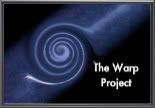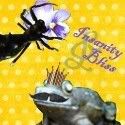We enter this episode of the Star Trek universe underground in a mining colony, facing a group of men dressed in either orange or yellow jumpsuits, fearful of a creature in the tunnels that has killed over 50 men by frying them to a crisp.
This episode offers us a new life form--that is a silicone based flesh eater.
 Kirk faces the Silicone-based Flesh Eater, the Horta
Kirk faces the Silicone-based Flesh Eater, the HortaOne of the amazing discoveries of this episode is the fact that alien life forms in any part of the universe turn out to be able to etch rock with English sentences. With the diversity of languages on Earth, I wouldn't have realized that the rest of the universe would turn out to be so homogeneous.
Episode Summary
"Devil in the Dark" reveals a creature called the horta that is made entirely of silicone, yet excretes acid. The acid allows it to move through rock, or any other material, including human flesh. Spock turns out able to mind meld even with silicone based creatures, and so discovers that the horta is the last of its currently conscious kind. Every 50,000 years all horta but one die, the one being left behind to tend to the eggs of the next generation. The miners, without realizing what they were doing, tap into the egg house area of the horta. In so doing, the last living (non-egg) horta protects its eggs the only way it knows how--by attacking the human miners.
The phasers of the Enterprise turn out to be damaging to the silicone based life. In doing so, the creature becomes easier to deal with. In realizing that the horta is no longer interested in hurting the crew or the miners, Kirk demands McCoy help the horta heal from its phaser burn injury. But the horta is effectively rock. Trying to help heal the creature is like working with brick or rock for McCoy. First refusing to assist because of the implausibility of the manuever, McCoy is finally able to help the horta with concrete and heat.
Episode Tidbits
Compassion for creatures genuinely different from our own is one of the lessons of this episode. The demand of this Star Trek episode is the idea that we are to have patience for the possibility that a creature utterly different from us could be revealed to our understanding over time. In a rare moment of release from his cavalier demeanor, Kirk illustrates for us the incredible uniqueness of experience that can come from allowing something we do not yet understand to reveal itself to us. What we discover is that in becoming open to what we did not know before we allow the possibility of being utterly changed, or being better than we were before. "The Devil in the Dark" offers us, then, two lessons--the value of new knowledge, first of all, and secondly an appreciation for life itself. Life, in other words, is something unique in the universe, even with incredible diversity, and so irreplacable. It is to be valued, even when we do not understand it.
As a quick forewarning, in case you intend to watch this episode: the monster revealed to us through "The Devil in the Dark" is the most horrifying possible demon we could ever fear to witness. That's right--in terms of its basic appearance, the horta is a locomoting pile of meatballs and tomato sauce.
O. My. God.
Episode Summary
"Devil in the Dark" reveals a creature called the horta that is made entirely of silicone, yet excretes acid. The acid allows it to move through rock, or any other material, including human flesh. Spock turns out able to mind meld even with silicone based creatures, and so discovers that the horta is the last of its currently conscious kind. Every 50,000 years all horta but one die, the one being left behind to tend to the eggs of the next generation. The miners, without realizing what they were doing, tap into the egg house area of the horta. In so doing, the last living (non-egg) horta protects its eggs the only way it knows how--by attacking the human miners.
"I'm a doctor, not a brick layer!"
The phasers of the Enterprise turn out to be damaging to the silicone based life. In doing so, the creature becomes easier to deal with. In realizing that the horta is no longer interested in hurting the crew or the miners, Kirk demands McCoy help the horta heal from its phaser burn injury. But the horta is effectively rock. Trying to help heal the creature is like working with brick or rock for McCoy. First refusing to assist because of the implausibility of the manuever, McCoy is finally able to help the horta with concrete and heat.
Episode Tidbits
Compassion for creatures genuinely different from our own is one of the lessons of this episode. The demand of this Star Trek episode is the idea that we are to have patience for the possibility that a creature utterly different from us could be revealed to our understanding over time. In a rare moment of release from his cavalier demeanor, Kirk illustrates for us the incredible uniqueness of experience that can come from allowing something we do not yet understand to reveal itself to us. What we discover is that in becoming open to what we did not know before we allow the possibility of being utterly changed, or being better than we were before. "The Devil in the Dark" offers us, then, two lessons--the value of new knowledge, first of all, and secondly an appreciation for life itself. Life, in other words, is something unique in the universe, even with incredible diversity, and so irreplacable. It is to be valued, even when we do not understand it.
As a quick forewarning, in case you intend to watch this episode: the monster revealed to us through "The Devil in the Dark" is the most horrifying possible demon we could ever fear to witness. That's right--in terms of its basic appearance, the horta is a locomoting pile of meatballs and tomato sauce.
O. My. God.






No comments:
Post a Comment